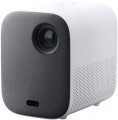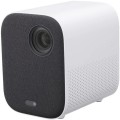Service life
Minimum projector lamp life as stated by the manufacturer. Specified by the total time of continuous operation. Note that if the projector was operated without violations, then upon reaching this time, the lamp will not necessarily fail — on the contrary, it can work for quite a long time. However, when evaluating durability, it is best to focus on the claimed service life.
Lamp power
The power consumption of the backlight lamp installed in the projector.
Theoretically, the more powerful the lamp, the brighter it is. However, this is only true when comparing lamps of the same type (see above); and even in this case, the brightness may also depend on the nuances of the design. Therefore, when evaluating the capabilities of a lamp, it is worth focus not so much on power, but on the directly claimed brightness in lumens (see below).
But what this parameter directly affects is the total power consumption of the projector: the lamp is the most “greedy” component of the device, compared to it, the power consumption of the rest of the electronics is very small. Also note that many powerful lamps have high heat dissipation and require cooling systems, which affects the size and weight of the projector.
Static contrast
The static contrast of the image provided by the projector.
Static contrast refers to the maximum difference between the brightest white light and the darkest black that a projector can provide within a single frame. Unlike dynamic contrast (see below), this parameter describes not conditional, but quite real capabilities of the device, achievable without the use of any additional tricks like auto-brightness. And since the quality of colour reproduction and detailing depend on contrast, the higher this indicator, the lower the likelihood that details will be indistinguishable in bright or dark areas.
Sensor size
The size of the sensor affects the depth and final quality of the image. The larger the sensor, the more light it is able to process, which means the picture will be clearer and more structured. The average projector has a sensor of 0.5-0.7″, advanced projectors use sensors of 1.2-1.5″ and more.
Image format support
Image formats supported by the projector.
In this case, format means the aspect ratio of the image. The general rule in this case is that the projector must support the same format in which the original content is recorded. Otherwise, the image will either be stretched in height or width, or with black stripes on the sides or top-bottom. Specifically, the formats can be divided into three main categories:
— Traditional, or
rectangular. Classic formats in which the height of the picture is not much less than the width. The most popular options are 4:3, widely used in analogue TV, and 5:4, common in computer technology. Traditional formats are well suited for presentations, working with documents and graphics, and other similar tasks.
—
Widescreen — formats in which the frame width is significantly (more than 1.5 times) greater than the height. The most popular of these standards are 16:9 and 16:10. These aspect ratios are well suited for games and movies; in particular, most high-definition content (HD 720p and above) is recorded in widescreen format.
—
Extra wide. The formats are even wider than the widescreen ones described above — for example, 21:9. Mainly used in cinematography.
It is worth noting that many modern projectors are able to work with several types of formats at once — for example, with classic 4:3 and
...wide-angle 16:9.HDR support
The projector supports
HDR technology — high dynamic range.
This technology allows to expand the range of brightness displayed within a single frame — in other words, to display both very bright and very dark colours on the screen at the same time. Due to this, colour reproduction is noticeably improved; in addition, in very bright or very dark areas of the frame, small details remain visible that would not be visible in a normal image. At the same time, it is worth noting that all the benefits of HDR become noticeable only on a high-end screen with maximum dimming. In addition, this function significantly affects the cost of the projector, and the content must initially be recorded in HDR — and using exactly the technology that the projector supports (this point can be clarified in the instructions). Because of this HDR support is found predominantly among high-end home theater models (see "Main purpose").
Throw distance, min
The closest distance to the screen that the projector can be used on. Typically, this is the minimum distance at which the image from the projector remains in focus.
This parameter is especially important if the device is to be placed at a small distance from the screen (for example, in a cramped room). Some modern projectors are able to work normally at a distance of 10 – 20 cm. Also note that the throw distances are determined primarily by the lens, and if the initial range of these distances does not suit you, perhaps the situation can be solved by replacing the optics.
Throw distance, max
The farthest distance from the screen that the projector can be used on. This is the maximum distance at which the image remains in focus and maintains acceptable brightness — at least enough for viewing in a darkened room on a high-quality screen.
It is necessary to choose according to this parameter taking into account the expected operating conditions and the distances to be dealt with. At the same time, it's ok to have a certain margin for the maximum distance — since, as already mentioned, it is usually indicated for an perfect screen and a darkened room, and such conditions are not always available. Also note that although the throw distances depend on the lens, not every projector with an interchangeable lens allows the installation of more "long-range" optics than the standard one — the device may simply not have enough brightness for an increased distance.
Image size
Diagonal size of the image projected by the projector. Usually, it is indicated as a range — from the smallest, at the minimum throw distance, to the largest, at the maximum. About throw distances, see above; here it is worth saying that the choice of diagonal size depends both on the distance between the screen and the audience, and on the format of the projector. For example, to watch a video, the best option is the situation when the distance from the viewer to the image corresponds to 3-4 diagonals, and a relatively large picture can be useful for working with presentations. More detailed recommendations for different situations can be found in special sources; here we only recall that the image must fit on the screen used with the projector.

